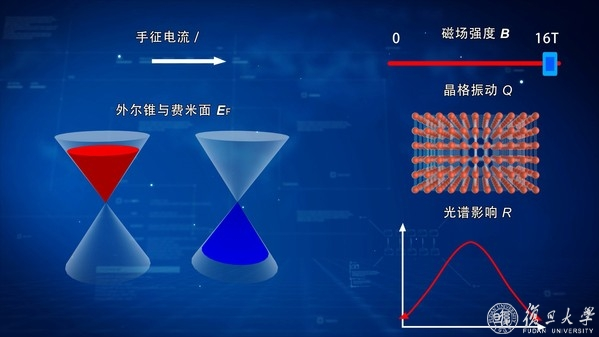Professor Faxian Xiu's research group and Hugen Yan's research group from the Department of Physics at Fudan University, and Professor Yi Shi's research group from the School of Electronic Science and Engineering at Nanjing University have discovered a unique electromagnetic response characteristic, namely dynamic chiral anomaly, in Weyl semimetals. On March 6th, the relevant research findings were published online in the journal Nature Communications 11, 1259 (2020), titled “The discovery of dynamic childhood in a Weyl semimetal NbAs”. This achievement was also reported in the form of News and Views by the journal Nature Physics (Xi Dai, Dynamic Anatomy, Nature Physics (2020), DOI: 10.1038/s41567-020-0844-6). The first unit of the paper is the Department of Physics at Fudan University, with Faxian Xiu, Hugen Yan, and Yi Shi as corresponding authors, and Xiang Yuan, Yi Zhang, and Cheng Zhang as co first authors.
Imagine a box containing chiral particles. If the number of opposite chiral particles is the same at the beginning, any time you open this box, you will see that there are equally many left-handed and right-handed particles. This is called chiral symmetry. But in the case of quantization, this symmetry will be broken.
In the experiment, there is a special type of material called Weyl semimetals, in which quasi particles (Weyl fermions) are similar to free space Weyl fermions and are a class of chiral fermions that appear in pairs in solids. Therefore, this special material can be seen as a box filled with left-handed and right-handed sex particles. Under an external magnetic field, the symmetry of the chiral structure will be broken, resulting in chiral anomalies. Strictly speaking, chiral anomaly describes the breaking of chiral symmetry generated by the quantization of relativistic fermions. In transport experiments, under parallel electric and magnetic fields, the Weyl semimetal system generates chiral magnetic currents along the direction of the electromagnetic field, resulting in observable negative magnetic resistance in the experiment.
At present, this chiral anomalous effect has been observed in many Weyl semimetals: static current in one direction is achieved by applying static electric and magnetic fields. However, up to now, there have been no reports on dynamic chiral anomalies under alternating electromagnetic fields, which precisely reflect the unique electromagnetic response characteristics of Weyl semimetals.
The electromagnetic response of Weyl semimetal can be described by an axial field, which is proportional to the dot product of the electric field and magnetic field. Except for chiral anomalies, the electromagnetic response of other non-metals such as the anomalous Hall effect can be described by this axial field. If a dynamic axial field can be achieved, the unique electromagnetic response of the outer half metal can be extended to finite frequency electromagnetic waves, achieving interaction with light. This requires the presence of AC components in the electric or magnetic field.
The work of the research group achieved dynamic chiral anomaly by combining the built-in electric field of phonons with an external static magnetic field. When the AC electric field generated by lattice vibration and the external magnetic field coexist and are parallel, a dynamic axial chiral magnetic current can be generated. The accumulation effect of this current, combined with strong electroacoustic coupling in the system, produces observable effects on phonons. This theoretical concept was first proposed by researcher Daisy. Through phonon detection techniques such as Raman spectroscopy and infrared spectroscopy, researchers first determined the phonon behavior in the zero field outer half metal niobium arsenide (supported by Professor Nanlin Wang for zero field infrared spectroscopy). There is a type of phonon that cannot be detected by infrared spectroscopy in a special direction under zero field. Previously, Professor Yaoming Dai from Nanjing University discovered that such phonons have strong electroacoustic interactions, which gives dynamic chiral anomalies a chance to be observed in this system.
Through infrared magnetic spectroscopy technology, researchers observed that this infrared invisible phonon gradually transformed into an infrared visible phonon as the magnetic field increased, consistent with the prediction of dynamic chiral anomalies. The researchers then conducted a series of experiments with different angles and configurations, using the classical control variable method to determine that the phonon charge generated by the magnetic field is consistent with the direction of the magnetic field, so it can only interact with electromagnetic waves polarized in the same direction. A similar phenomenon was also observed in the Dirac semimetal cadmium arsenide, with the same magnetic field variation trend. This research achievement has achieved dynamic chiral anomalies for the first time in Weyl semimetals, providing an experimental basis for studying the electromagnetic response characteristics and future applications of this type of material.

Figure. Schematic diagram of dynamic chiral anomaly of NbAs
Paper link: https://www.nature.com/articles/s41467-020-14749-4